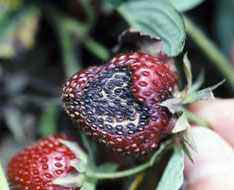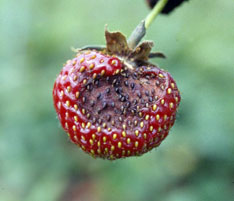Warm, wet conditions can promote anthracnose fruit rot in strawberries
Editor’s note: This article is from the archives of the MSU Crop Advisory Team Alerts. Check the label of any pesticide referenced to ensure your use is included.
The warm, wet conditions of the past week promote fungal disease development in strawberries, in particular anthracnose fruit rot. Foliar fungal diseases, such as Phomopsis leaf blight, scorch, and leaf spot also develop more rapidly in response to lots of rain and leaf wetness. Since we are currently at harvest, it is important to scout for fruit rots. Most people are aware of Botrytis gray mold, which is also a risk, but fewer may be familiar with anthracnose fruit rot. Anthracnose fruit rot is characterized by dark, circular sunken areas on fruit. This disease is usually caused by the fungus Colletotrichum acutatum, but other Colletotrichum species may also be involved. The fungus may also cause petiole and runner infections, flower blight, and anthracnose crown rot. Flowers and ripening fruit are very susceptible to anthracnose fruit rot. The pathogen can spread rapidly through fruiting fields during rainy, warm periods. Irrigation to help cool down the berries may also contribute to spread and infection.
The first symptoms of anthracnose fruit rot are light brown, water-soaked spots on ripening fruit. The spots quickly develop into firm, round lesions, which usually turn dark brown to black and become slightly sunken. Under humid conditions, salmon-colored spore masses cover the lesions. Spore production, spore germination, and infection of strawberry fruit are favored by warm, humid weather. This explains why we often see anthracnose fruit rot appearing later in the picking season. Conidia are produced in a slimy matrix and are easily dispersed by splashing rain or by insects, animals or people moving through the field. Infected berries eventually dry up and mummify and can become a source of inoculum for the following season. C. acutatum is known to survive in infected plant material for up to nine months.
Anthracnose fruit rot is very difficult to control when environmental conditions are favorable for infection during harvest. Therefore, control measures must begin early in the season. When planting a new field, start out with disease-free planting material. However, it is very difficult to detect the fungus in planting material because it causes latent (invisible) infections. The best approach at this point is to choose a reputable source of planting material. The spread of inoculum in the field can be reduced by mulching row middles with straw and using drip irrigation rather than overhead irrigation. Fruit with anthracnose lesions should be promptly removed from the field to reduce inoculum levels, especially early in the harvest season. Anthracnose fruit rot can be controlled by applying fungicides like Captan, Cabrio, Abound, Pristine, Switch, or Captevate. Of these, Pristine, Switch, and Captevate also provide good to excellent control of Botrytis gray mold. Furthermore, Cabrio, Abound, and Pristine provide broad-spectrum control of foliar diseases. If you have angular leaf spot caused by Xanthomonas fragariae (a bacterium), this can only be controlled with copper products.



 Print
Print Email
Email




